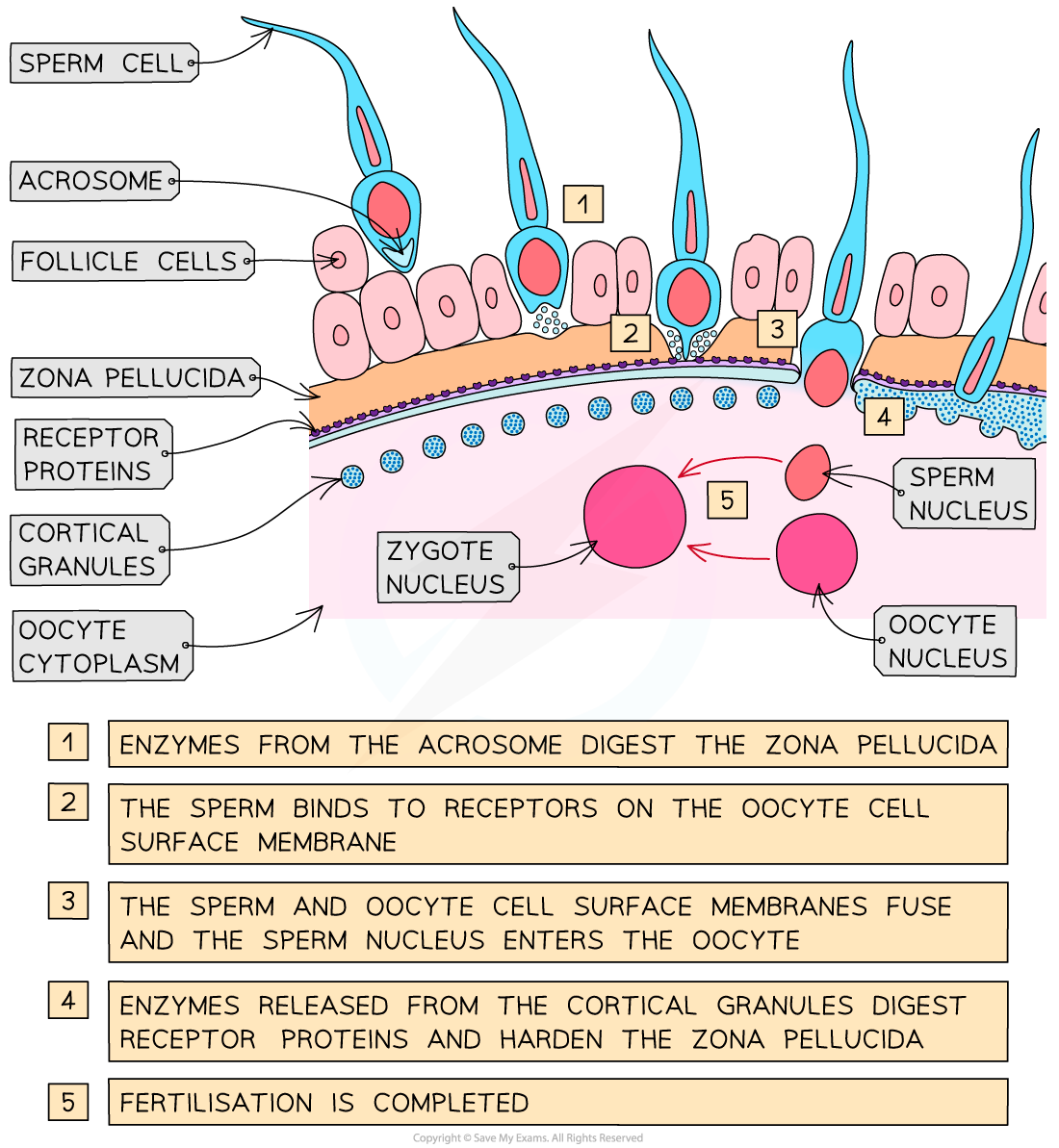Preventing Polyspermy
- Fertilisation is the fusion of one sperm cell and one ovum; this fusion of two haploid nuclei gives rise to a diploid zygote
- During sexual reproduction, many sperm are released, and the sperm cells are attracted towards the secondary oocyte by chemical signals
- Remember that at this point in the oogenesis process, meiosis II has not yet been completed, so the female gamete is still a secondary oocyte and not yet an ovum
- When the sperm cells reach the secondary oocyte, the process that takes place at its cell surface prevents more than one sperm from passing through its cell surface membrane
- The entry of more than one sperm into a single oocyte is known as polyspermy
- The oocyte is surrounded by a layer of follicle cells, as well as a layer of glycoproteins known as the zona pellucida
- The sperm cells need to digest the glycoproteins of the zona pellucida in order to reach the oocyte cell surface membrane; they do this by releasing digestive enzymes from a structure called the acrosome
- This is known as the acrosome reaction
- When the first sperm cell digests its way through the zona pellucida, it reaches the oocyte cell surface membrane; complementary receptors on the head of the sperm bind with proteins on the oocyte cell surface membrane, enabling the cell surface membranes of the two gametes to fuse together and the sperm nucleus to enter the oocyte
- At this point the process of meiosis II continues, leading to the release of the second polar body and the formation of the mature ovum
- The fusion of the two cell surface membranes triggers the movement of a series of vesicles called cortical granules; the vesicles move from the outer layer of the ovum cytoplasm to the cell surface membrane, releasing enzymes that digest the binding proteins on the cell surface of the ovum and that cause the zona pellucida to harden
- This is the cortical reaction
- The enzymes are released by the process of exocytosis
- Once the binding proteins have been broken down and the zona pellucida has hardened, no more sperm cells can enter the ovum; polyspermy is prevented
- Inside the ovum the male and female nuclei fuse together and fertilisation is completed

Mechanisms during the process of fertilisation prevent polyspermy
Internal & External Fertilisation
- Fertilisation is the fusion of one sperm cell and one ovum
- Sperm cells tend to be mobile, or motile, enabling them to move towards the ovum
- For sperm to be able to move towards the ovum they need to be released into a fluid medium
- Aquatic animals are constantly surrounded by a fluid medium, so sperm can be released directly into the environment and fertilisation can take place outside the body; this is external fertilisation
- Animals that carry out external fertilisation include fish and amphibians
- In external fertilisation the risks of gametes being eaten by predators or washed away from each other are high, so species that carry out external fertilisation often release both ova and sperm into the water in very large quantities to increase the chances of reproducing successfully
- Male land animals release sperm, along with fluid produced in their bodies, into the internal reproductive tract of the female animal; this is internal fertilisation
- Animals that carry out internal fertilisation include birds and mammals
- Internal fertilisation ensures that the gametes are in close proximity to each other and that they are protected from predation, so gamete numbers tend to be smaller
- ova are often released one at a time in this type of fertilisation
- In humans the fluid is known as semen; sperm and semen are released into the female vagina during sexual intercourse
